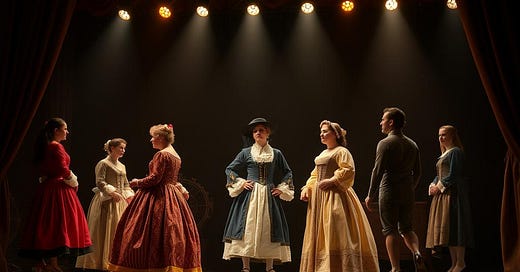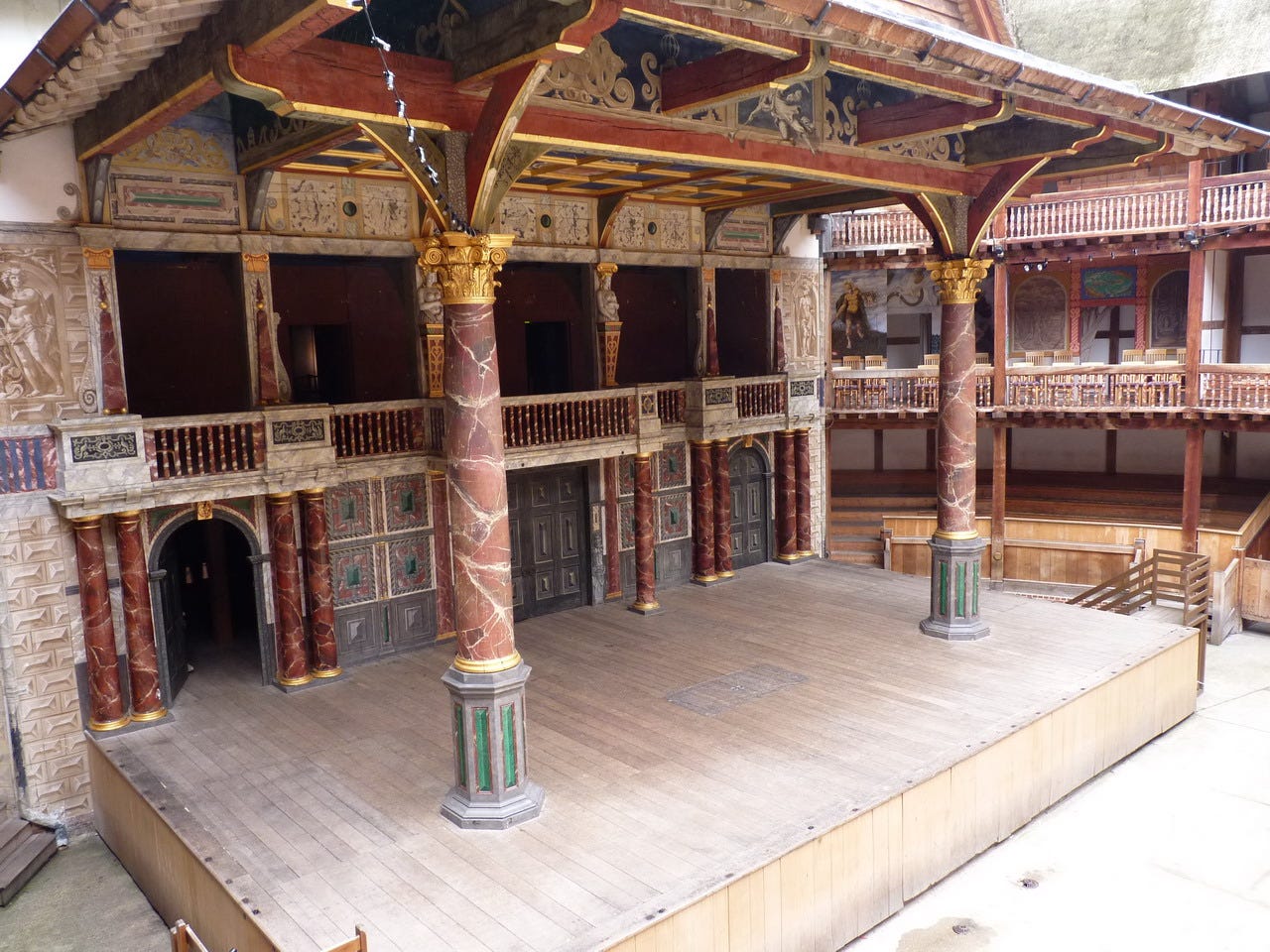How to Study Shakespeare's Plays in Performance
A look into the fascinating task of the theatre historian!
We read Shakespeare’s plays, we teach them in classrooms, we discuss them in conferences, but sometimes we forget the crucial element to really understand and appreciate a play: performance.
Shakespeare’s plays were written to be performed on the stage, yet many studies focus primarily on their textual analysis. While the literary aspects of the plays are significant, engaging with their performance history can offer deeper insights into their meaning, interpretation, and cultural impact. This is the aim of theatre historiography, the study of how theatrical performances are recorded, interpreted, and remembered, which provides a valuable framework for exploring Shakespeare’s works in performance.
This type of research into theatrical adaptations of the past is what I have been doing academically for the past 10 years: since my first MA in 2015, when I looked into an 1842 production of Shakespeare’s King John at the Royal Theatre Drury Lane, through my PhD, when I investigated 19th-century productions of Richard II. It is such a dynamic and engaging area of research that I’ve decided to share it with you!
Theatrical contexts and original practices
Understanding the historical conditions under which Shakespeare’s plays were first performed can illuminate the playwright’s intentions and the expectations of his audiences. The open-air playhouses of Elizabethan and Jacobean London such as the Globe had specific staging conventions: minimal scenery, direct audience address, and an all-male cast. Studying these original practices helps us consider how Shakespeare crafted his plays for performance rather than just for the page. After all, the dramatic text only reaches its full potential when it comes to life on stage.
One key element of early modern performance was the physical structure of the theatre itself. The thrust stage of the Globe allowed actors to be surrounded on three sides by spectators, fostering a sense of immediacy and engagement. Without elaborate set designs, productions relied on costumes, props, and language to establish setting and atmosphere. The absence of artificial lighting meant performances took place during daylight hours, affecting the pacing and delivery of lines.
The stage of the Globe Theatre, London. Photo by Richard Law
Archival traces and stage history
Theatre historiography also involves examining the material evidence of past productions. While we lack recordings of early modern performances, we have playhouse documents, actors’ annotations, promptbooks, reviews, and visual representations of later adaptations. By analyzing these archival traces, we can reconstruct how Shakespeare’s plays have been staged across different periods, revealing shifts in cultural attitudes and theatrical conventions. It is like a detective work, and it is fascinating!
Promptbooks, which contain annotations on how a play was performed, offer detailed insights into past productions. These books often include notes on blocking, cuts to the text, and even lighting or sound cues in later productions, helping us understand the interpretive choices made by directors and actors. Reviews from newspapers and periodicals provide further context, reflecting contemporary audience reactions and critical debates about particular performances.
Below is an example of a record a theatre historian can rely on in order to reconstruct a past performance. This is an illustration of the actor William Charles Macready (1793-1873) in the role of Richard II in Shakespeare’s play. Based on what we see in the illustration, we can imagine how the actor may have looked like on stage—as well as hints regarding the set design!
Case studies: productions and adaptations
Certain productions have redefined how Shakespeare is performed and understood. The elaborate Restoration adaptations, 19th-century star performances, and 20th-century experimental stagings all tell us as much about the societies that produced them as about Shakespeare himself. Studying these key productions within their historical context highlights the evolving nature of Shakespearean performance and reception.
Restoration Adaptations (1660s-18th century): After the reopening of the theatres in 1660, Shakespeare’s plays were frequently adapted to fit the tastes of the period. For example, The Tempest was reworked by John Dryden and William Davenant to include new characters and songs, reflecting Restoration-era preferences for spectacle and music. King Lear was famously given a happy ending by Nahum Tate, showing how political and cultural attitudes shaped the reception of Shakespeare’s works.
19th-Century Star Performances: The 19th century saw the rise of actor-managers who put their own stamp on Shakespearean roles. Henry Irving’s Hamlet (1874) emphasized psychological depth and elaborate staging, while Edwin Booth’s performances in the United States set a precedent for a more introspective, tragic interpretation. These productions highlight how individual actors could redefine Shakespeare for new generations.
20th-Century Experimental Stagings: The 20th century brought radical reinterpretations of Shakespeare’s plays. Peter Brook’s King Lear (1962) stripped down the play to its raw emotional core, while his A Midsummer Night’s Dream (1970) used a minimalist white box set to challenge traditional notions of realism. The Royal Shakespeare Company and the Globe Theatre have continued to experiment with modern-dress productions, gender-swapped casting, and immersive staging, demonstrating how Shakespeare remains a living, adaptable playwright.
Digital and Global Adaptations in the 21st Century: More recently, Shakespeare’s plays have been reimagined through digital performances and cross-cultural adaptations. The Globe to Globe festival in 2012 featured Shakespeare’s works performed in multiple languages, showcasing their global resonance. Digital theatre productions, such as the National Theatre’s online broadcasts, allow new audiences to experience Shakespeare in innovative ways, proving that his plays continue to evolve in response to technological and cultural shifts.
A theatre historiographical approach in practice
When studying a Shakespeare play through theatre historiography, consider these steps:
Investigate primary sources: Look at promptbooks, reviews, and theatre records to uncover how past performances were staged.
Compare different productions: Analyze how interpretations have changed over time and across cultures.
Examine audience reception: What did contemporary audiences think? How did cultural and political contexts shape their responses?
Reflect on your own perspective: How does our modern understanding of theatre influence the way we interpret Shakespeare today?
By integrating theatre historiography into Shakespeare studies, we gain a richer, more dynamic appreciation of his plays, not just as literary texts but as living performances that collect new layers of meaning with each new staging.







The Genius of Shakespeare ‒ Starre of Poets; a Moniment, without a tombe; not of an age, but for all time! https://aworldeofwordes.substack.com/p/the-genius-of-shakespeare?r=5d7dmx
I am a BA Philosophy graduate of University of London and MA SocialPolicy&Research UoEast London (England). Although both have been analytic and statistic traditionally based degrees I am not academic and rather more pragmatic and arts leaning. I am experimenting on substack with an experimental and as far as I know unusual non-traditional form of algorythm punctuation computer gaming form of writing as a kind of prose poetry or proem and would be interested in any remarks you may wish to make if you are so inclined. https://mstow.substack.com/publish/home?utm_source=menu